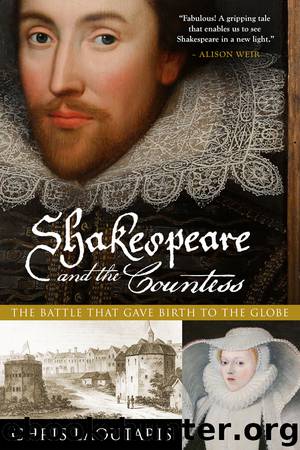Shakespeare and the Countess by Chris Laoutaris

Author:Chris Laoutaris
Language: eng
Format: epub
Publisher: Pegasus
Published: 2015-03-14T16:00:00+00:00
19.
In the Name of Love
In 1596–7 the Cecils and William Brooke, as representatives of the Privy Council, had come to believe that in seditious hands the theatres could become the focal points of civil unrest, a view shared passionately by Elizabeth Russell. The Earl of Essex was riding high after his success in Cadiz and, with the opening of the Blackfriars Theatre, would have acquired a new vehicle for the propaganda that was upsetting the balance of power in an ever more volatile court.
It would not have escaped Essex’s attention that one of the men responsible for targeting the theatres, Elizabeth’s associate Richard Martin, had also been attempting to ruin his family financially from the winter of 1593. Martin was suing his mother, Lettice Knollys, demanding an eyewatering £2,123 from the Earl of Leicester’s estate, close to £270,000 today, Tor plate sold to the Earl’. Although Martin’s machinations while Lord Mayor had dented the fortunes of Shakespeare’s company, it was Elizabeth’s petition that abruptly put a stop to any plans the playwright may have had of moving his Oldcastle plays – with their aggrandizing of Essex’s ancestral line and mockery of the Cobhams and Russells – to the Burbages’ indoor playhouse. Shakespeare would have been aware, because it was included in one of his principal sources, Holinshed’s Chronicles, that it was ’in the hall of the Black Friars at London’ in which the Brookes’ ancestor, Oldcastle, had been ‘examined … [and] denounced an heretic’; the very same room that became Shakespeare’s Blackfriars Theatre. In this venue the Oldcastle plays would have acquired a dangerous immediacy. Since Robert Cecil was married to Lord Cobham’s daughter, Elizabeth Brooke, he would have also had a vested interest in protecting his children’s legacy and was only too eager to believe his aunt’s claim that the new theatre would be used as the cover for ‘all manner of mischief’.
Already crippled by the closure of the theatres due to the plague, and on the verge of losing their Shoreditch Theatre, Shakespeare’s troupe was left without an indoor venue and facing bankruptcy. Elizabeth’s kinsmen on the Privy Council chose this time to strike a further blow by intervening to censor the dramatist’s plays directly. This could have been skilfully stage-managed only through the intercession of William Brooke, Lord Cobham, who became Lord Chamberlain from 8 August 1596, after the death of Henry Carey. George Carey was frustrated in his attempts at gaining his father’s former post, which gave its holder the power to license and censor plays. He had also been denied a place on the Privy Council, which meant he could not follow the elder Carey’s example and serve as a buffer between the Queen’s Councillors and the players. Henry Carey may have originally licensed Henry IV, Part 1 with Oldcastle and John Russell in the character list, but this would not stop his successor from subjecting Shakespeare to the humiliating reprimands of censorship. Under investigation by the authorities, the playwright was forced to expunge John Russell and Harvey from his play and change the name Sir John Oldcastle.
Download
This site does not store any files on its server. We only index and link to content provided by other sites. Please contact the content providers to delete copyright contents if any and email us, we'll remove relevant links or contents immediately.
| Ancient & Classical | Arthurian Romance |
| Beat Generation | Feminist |
| Gothic & Romantic | LGBT |
| Medieval | Modern |
| Modernism | Postmodernism |
| Renaissance | Shakespeare |
| Surrealism | Victorian |
4 3 2 1: A Novel by Paul Auster(11064)
The handmaid's tale by Margaret Atwood(6866)
Giovanni's Room by James Baldwin(5889)
Big Magic: Creative Living Beyond Fear by Elizabeth Gilbert(4730)
Asking the Right Questions: A Guide to Critical Thinking by M. Neil Browne & Stuart M. Keeley(4591)
On Writing A Memoir of the Craft by Stephen King(4220)
Ego Is the Enemy by Ryan Holiday(3999)
Ken Follett - World without end by Ken Follett(3980)
The Body: A Guide for Occupants by Bill Bryson(3813)
Bluets by Maggie Nelson(3721)
Adulting by Kelly Williams Brown(3678)
Guilty Pleasures by Laurell K Hamilton(3590)
Eat That Frog! by Brian Tracy(3521)
White Noise - A Novel by Don DeLillo(3439)
The Poetry of Pablo Neruda by Pablo Neruda(3370)
Alive: The Story of the Andes Survivors by Piers Paul Read(3317)
The Bookshop by Penelope Fitzgerald(3234)
The Book of Joy by Dalai Lama(3224)
Fingerprints of the Gods by Graham Hancock(3218)
